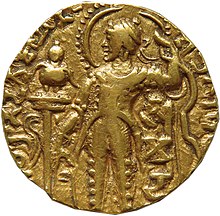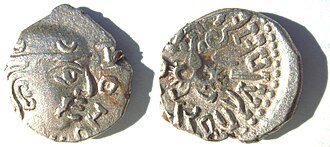GUPTA DYNASTY 240 to 590 CE.
the Gupta Empire was an ancient Indian empire, existing from approximately 240 to 590 CE. At its zenith from approximately 319 to 550 CE it covered much of the Indian subcontinent.[2] This period is called the Golden Age of India.[3][note 1] The ruling dynasty of the empire was founded by Sri Gupta; the most notable rulers of the dynasty were Chandragupta I, Samudragupta, and Chandragupta II. The 5th-century CE Sanskrit poet Kalidasa credits the Guptas with having conquered about twenty-one kingdoms, both in and outside India, including the kingdoms of Parasikas, the Hunas, the Kambojas, tribes located in the west and east Oxus valleys, the Kinnaras, Kiratas, and others.[5
Kumaragupta I, also known as Shakraditya[3] and Mahendraditya[citation needed], was an emperor of the Gupta Empire in 415–455 CE. He was the son of his predecessor, Chandragupta II, and Dhruvadevi (also known as Dhruvasvamini).[4] He was an able ruler and retained, intact, the vast empire, which extended from Bengal to Kathiawar and from the Himalayas to the Narmada. He ruled efficiently for nearly forty years. However, the last days of his reign were not good. The Gupta Empire was threatened by the rebellion of Pushyamitras of central India and invasion of the White Huns (probably the Kidarites). But, Kumaragupta was successful in defeating both threats and performed the Ashvamedha (horse sacrifice) to celebrate his victory. He issued new coins with images of his namesake, Lord Kumara.
Decline of the Gupta Empire
Inscriptions prove that the Gupta sovereignty was acknowledged in the Jabalpur region in the Narmada valley as late as CE 528, and in North Bengal till CE 543–544. Kumaragupta II is believed to have been ruling in 473–474 CE and Buddhagupta from 476–495 CE

Garuda pillar. British Museum.

(Coin of his Western territories, design derived from the Western Satraps).
Obv: Bust of king with crescents, with traces of corrupt Greek script.[34][35]
Rev: Garuda standing facing with spread wings. Brahmi legend:
Obv: Bust of king with crescents, with traces of corrupt Greek script.[34][35]
Rev: Garuda standing facing with spread wings. Brahmi legend:
Parama-bhagavata rajadhiraja Sri Kumaragupta Mahendraditya.
| Gupta Empire 320 CE–550 CE | ||||||||||||||||||||||||||||||||||||
|---|---|---|---|---|---|---|---|---|---|---|---|---|---|---|---|---|---|---|---|---|---|---|---|---|---|---|---|---|---|---|---|---|---|---|---|---|
|



No comments:
Post a Comment